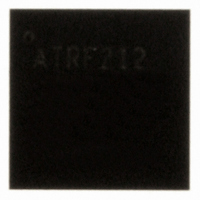AT86RF212-ZU Atmel, AT86RF212-ZU Datasheet - Page 91

AT86RF212-ZU
Manufacturer Part Number
AT86RF212-ZU
Description
IC TXRX ZIGBE/802.15.4/ISM 32QFN
Manufacturer
Atmel
Datasheet
1.AT86RF212-ZU.pdf
(172 pages)
Specifications of AT86RF212-ZU
Frequency
700MHz, 800MHz, 900MHz
Data Rate - Maximum
250kbps
Modulation Or Protocol
802.15.4 Zigbee, 6LoWPAN, ISM
Applications
ISM, ZigBee™
Power - Output
10dBm
Sensitivity
-110dBm
Voltage - Supply
1.8 V ~ 3.6 V
Current - Receiving
9.2mA
Current - Transmitting
25mA
Data Interface
PCB, Surface Mount
Antenna Connector
PCB, Surface Mount
Operating Temperature
-40°C ~ 85°C
Package / Case
32-VQFN Exposed Pad, 32-HVQFN, 32-SQFN, 32-DHVQFN
Number Of Receivers
1
Number Of Transmitters
1
Wireless Frequency
769 MHz to 935 MHz
Interface Type
SPI
Noise Figure
7 dB
Output Power
21 dB
Operating Supply Voltage
1.8 V, 3 V
Maximum Operating Temperature
+ 85 C
Mounting Style
SMD/SMT
Maximum Supply Current
25 mA
Minimum Operating Temperature
- 40 C
Modulation
OQPSK
Protocol Supported
802.15.4
Operating Temperature (min)
-40C
Operating Temperature (max)
85C
Operating Temperature Classification
Industrial
Lead Free Status / RoHS Status
Lead free / RoHS Compliant
Memory Size
-
Lead Free Status / Rohs Status
Lead free / RoHS Compliant
Available stocks
Company
Part Number
Manufacturer
Quantity
Price
Company:
Part Number:
AT86RF212-ZU
Manufacturer:
HITTITE
Quantity:
5 000
Part Number:
AT86RF212-ZU
Manufacturer:
ATMEL/爱特梅尔
Quantity:
20 000
Part Number:
AT86RF212-ZUR
Manufacturer:
MICROCHIP/微芯
Quantity:
20 000
6.8 Link Quality Indication (LQI)
6.8.1 Requirements
6.8.2 Implementation
6.8.3 Obtaining the LQI Value
6.8.4 Remarks
8168C-MCU Wireless-02/10
The IEEE 802.15.4 standard defines the LQI as a characterization of the strength
and/or quality of a received frame. The use of the LQI result by the network or
application layer is not specified in this standard. The LQI value shall be an integer
ranging from 0 to 255, with at least 8 unique values. The minimum and maximum LQI
values (0 and 255) should be associated with the lowest and highest quality compliant
signals, respectively, and LQI values in between should be uniformly distributed
between these two limits.
During symbol detection within frame reception, the AT86RF212 uses correlation
results of multiple symbols in order to compute an estimate of the LQI value. This is
motivated by the fact that the mean value of the correlation result is inversely related to
the probability of a detection error.
LQI computation is automatically performed for each received frame, once the SHR has
been detected. LQI values are integers ranging from 0 to 255 as required by the IEEE
802.15.4 standard.
The LQI value is available, once the corresponding frame has been completely
received. This is indicated by the interrupt IRQ_3 (TRX_END). The value can be
obtained by means of a frame buffer read access, see section 4.3.2.
The reason for a low LQI value can be twofold: a low signal strength and/or high signal
distortions, e.g. by interference and/or multipath propagation. High LQI values,
however, indicate a sufficient signal strength and low signal distortions.
Note that the LQI value is almost always 255 for scenarios with very low signal
distortions and a signal strength much greater than the sensitivity level. In this case, the
packet error rate tends towards zero and increase of the signal strength, i.e. by
increasing the transmission power, cannot decrease the error rate any further.
Received signal strength indication (RSSI) or energy detection (ED) can be used to
evaluate the signal strength and the link margin.
ZigBee networks often require identification of the “best” routing between two nodes.
LQI and RSSI/ED can be applied, depending on the optimization criteria. If a low frame
error rate (corresponding to a high throughput) is the optimization criteria, then the LQI
value should be taken into consideration. If, however, the target is a low transmission
power, then the RSSI/ED value is also helpful.
Various combinations of LQI and RSSI/ED are possible for routing decisions. As a rule
of thumb, information on RSSI/ED is useful in order to differentiate between links with
high LQI values. However, transmission links with low LQI values should be discarded
for routing decisions, even if the RSSI/ED values are high, since it is merely an
information about the received signal strength, whereas the source can be an interferer.
AT86RF212
91













